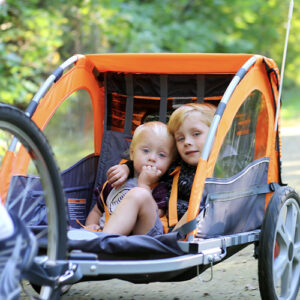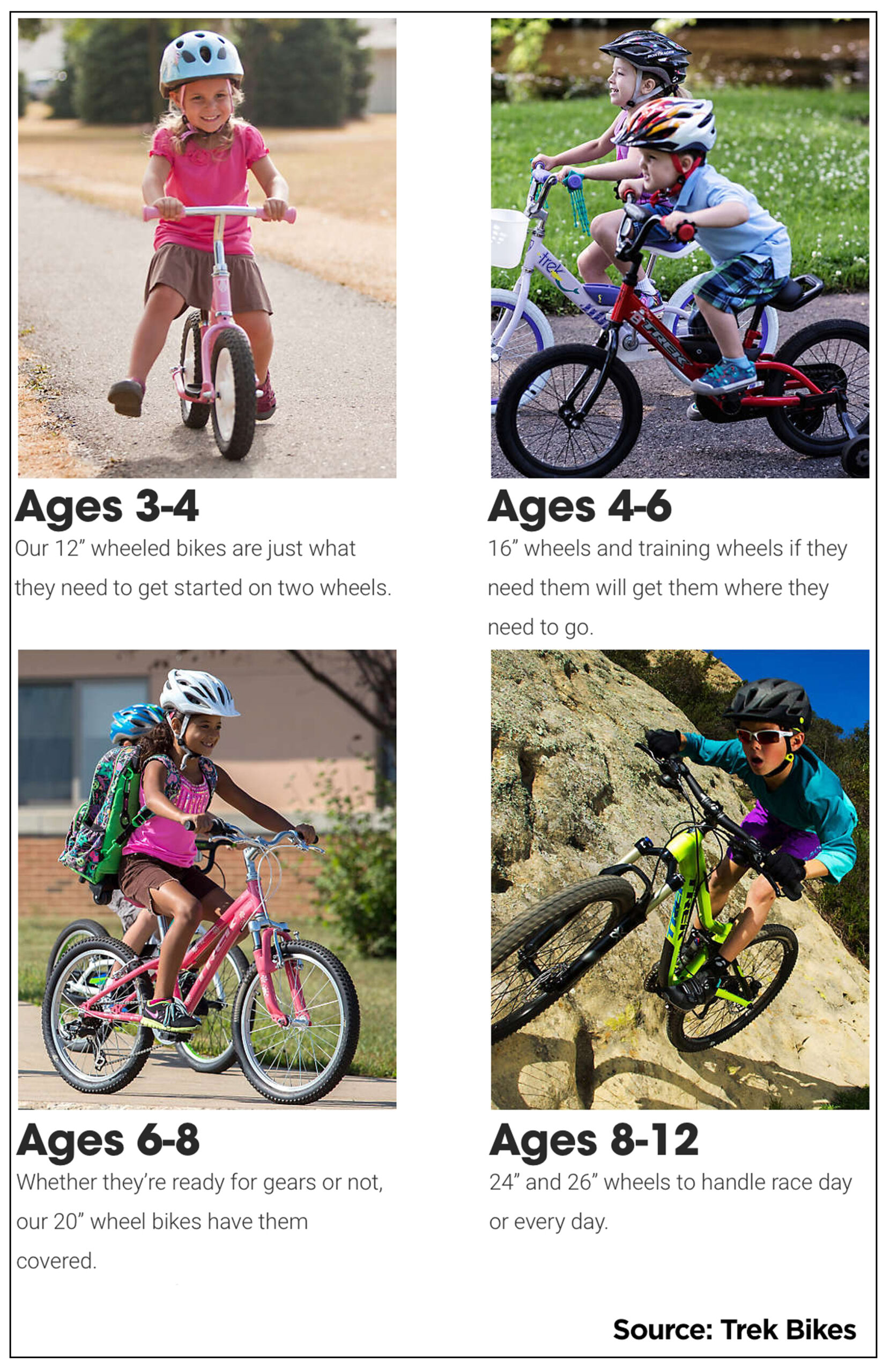Make sure your family enjoys a healthy, happy and safe bike experience by using the best ride-along options. ORA’s Dr. Andrew Bries and Rock Valley Physical Therapist Anna Perry walk you through the details.
Finding the right ride-along option for your kids
Bicycling is an activity the whole family can enjoy. To make sure your clan enjoys a healthy, happy and safe experience, take some time out to understand your ride-along options and take advantage of the options available to you and your kids.
Q: When it comes to riding with children, what are the safe options?
Dr. Bries:
If you’ve been an intense biker and you’re now riding with your kids, there are a few things you need to now consider. First, helmets for everyone! It doesn’t matter if your trailer has rollover protection, it is never too soon to teach your kids they must, without question, always wear a helmet when on wheels.
It’s also a good idea to check with your pediatrician before you take your child out on a bike — no matter what kind of accessory you select — to be sure that he or she is developmentally ready for the experience. Of course, it’s also important to choose the right bike for the right age.

Dr. Andrew Bries, Sports Medicine, ORA Orthopedics
When it comes to kids and bike safety, you want to choose a bike your child can handle. But more importantly is the environment in which they ride and their vigilance to objects around them. When learning, kids will fall and scrape their knees and hands, but for the most part, no permanent damage is done. When starting out, we always had our kids ride where we could see them and hear them to give them safety cues.
We always make them wear helmets, even when in trailers. It’s never too soon to learn that bikes and helmets go together! When riding as a family, we stick to trails, as our kids aren’t ready to ride with cars. We use the mistakes they make as opportunities to teach and reinforce safety rules.
As far as equipment goes for the younger kids that can’t ride but can support their heads, I’m a big fan of trailers. The trailer allows the child to be right there with you, as well as communicate verbally. A good trailer will stay upright, even if you tip your bike, been there and done that. A trailer will also allow you to bring toys, snacks and anything else you’d like to bring along.
After our kids learned to balance on a bike but couldn’t keep up with us on trails, we moved them to a tag-along type bike that attached to ours so they felt like they are participating more. Now all of my kids have their own bike. They are still not full speed that we could ride 20-30 miles without some griping, but perfect for a 6-8 mile ride that includes an ice cream stop!
Here are the types of trailers and tagalongs for parents and their kids:

Bike-mounted child seat
Bike-mounted child seat:
Ages 1- 5 years
How they work:
These are placed behind or in front of a cyclist’s seat and can be used with children ages 1 to 5. (They face forward.) The added weight of a bicycle-mounted seat can affect the handling of the bike. This can be unnerving or just annoying, depending on your cycling abilities. A child would have a fall of about 3 feet from a mounted bike seat, which increases the possibility and potential severity of an injury. Source: Consumer Reports
Dr. Bries’s safety or riding tips:
Hard core bikers like these, but I have to admit the medical professional in me doesn’t like them. It increases the chance of making your child a projectile if you should fall or wreck. Remember, none of us ever plans to wreck, but it happens! These seats can also really mess with your balance if your child is shifting erratically from side-to-side. The kids like the view better and it’s a more exhilarating experience, but in my opinion not work the risk.

Bike trailer
Bike Trailer:
Ages 1-6 years
How they work:
These look like little sidecars attached to a bike’s rear axle or frame. They can carry children ages 1 to 6 years. Some models carry one child; others can carry two. All models have a weight limit that ranges from 85 to 125 pounds (this range sounds quite high for kids who are only 1 to 6 years old). Exceeding the limit can compromise the bike trailer’s structure. Children are seated, strapped into the carriers, and usually enclosed in a zippered compartment that protects them from the elements. Unlike bike seats, trailers are low to the ground, which can reduce possible injuries from falls. But this low profile makes them difficult for drivers to see. Bike trailers should only be used on trails, never where there is vehicular traffic. Even then, they should have an orange safety flag that’s 3½ feet to 7 feet high. Most models have a hitching device that will keep the trailer steady if the bike tips over. Source: Consumer Reports
Dr. Bries’s safety or riding tips:
This is my preferred way to transports kids and pets! Trailers are by far safer and allow more versatility. We actually had one that converted to a jogging stroller so my wife could walk the kids to the park in it when not biking.The trailer can be an equalizer when riding with kids. I used to be a stronger biker than my wife, so I’d typically pull the kids so we could both get a good workout.

One-wheeled bike extension
One-Wheel Extension Trailer Bike or (brand Trail-a-bike)
Ages: 3-6 years
How they work:
These are one-wheel extensions that attach to the seat post or a special rack on a bike for an adult. They’re a good choice when your child is slightly older, would like to do some pedaling, but can coast when he gets tired. Trailer cycles don’t have brakes. They’re designed so that they won’t affect your cycling (think of them as a coaster wheel in back of your bike). Source: Consumer Reports
Dr. Bries’s safety or riding tips:
They’re a good choice when your child is slightly older, would like to do some pedaling, but can coast when he gets tired. Trailer cycles don’t have brakes. They’re designed so that they won’t affect your cycling (think of them as a coaster wheel in back of your bike).
Consider, too, that a bike trailer loaded with a couple of kids can weigh up to 100 pounds. Do you have the bike skills and stamina to haul the load? The challenge will be even greater if you ride on hilly trails.
Youth Bikes
Now that our kids are older, we all have our own bikes and our rides are more for fun! It’s exciting when your kids learn to ride, but be patient and safe. Be a good example and use the appropriate safety gear and teach them the rules of the road.
When your kids start wanting to ride their own bikes, usually between the ages of 4-6, there are different bikes for age ranges. Check with your local bike shop or reputable manufacturers online to get more information on the type and size of bike so your kids will safely enjoy and build a love for cycling for a lifetime.
The biggest advice I was given for buying young kids bikes is don’t spend a ton of money as your kid is going to outgrow it quickly. In our family, we have mid-range bikes that have been passed between the cousins/neighbors as they grew out of their current bikes.

Finding the right ride-along option for your kids
Bicycling is an activity the whole family can enjoy. To make sure your clan enjoys a healthy, happy and safe experience, take some time out to understand your ride-along options and take advantage of the options available to you and your kids.
Q: When it comes to riding with children, what are the safe options?
Dr. Bries:
If you’ve been an intense biker and you’re now riding with your kids, there are a few things you need to now consider. First, helmets for everyone! It doesn’t matter if your trailer has rollover protection, it is never too soon to teach your kids they must, without question, always wear a helmet when on wheels.
It’s also a good idea to check with your pediatrician before you take your child out on a bike — no matter what kind of accessory you select — to be sure that he or she is developmentally ready for the experience. Of course, it’s also important to choose the right bike for the right age.

Dr. Andrew Bries, Sports Medicine, ORA Orthopedics
When it comes to kids and bike safety, you want to choose a bike your child can handle. But more importantly is the environment in which they ride and their vigilance to objects around them. When learning, kids will fall and scrape their knees and hands, but for the most part, no permanent damage is done. When starting out, we always had our kids ride where we could see them and hear them to give them safety cues.
We always make them wear helmets, even when in trailers. It’s never too soon to learn that bikes and helmets go together! When riding as a family, we stick to trails, as our kids aren’t ready to ride with cars. We use the mistakes they make as opportunities to teach and reinforce safety rules.
As far as equipment goes for the younger kids that can’t ride but can support their heads, I’m a big fan of trailers. The trailer allows the child to be right there with you, as well as communicate verbally. A good trailer will stay upright, even if you tip your bike, been there and done that. A trailer will also allow you to bring toys, snacks and anything else you’d like to bring along.
After our kids learned to balance on a bike but couldn’t keep up with us on trails, we moved them to a tag-along type bike that attached to ours so they felt like they are participating more. Now all of my kids have their own bike. They are still not full speed that we could ride 20-30 miles without some griping, but perfect for a 6-8 mile ride that includes an ice cream stop!
Here are the types of trailers and tagalongs for parents and their kids:

Bike-mounted child seat
Bike-mounted child seat:
Ages 1- 5 years
How they work:
These are placed behind or in front of a cyclist’s seat and can be used with children ages 1 to 5. (They face forward.) The added weight of a bicycle-mounted seat can affect the handling of the bike. This can be unnerving or just annoying, depending on your cycling abilities. A child would have a fall of about 3 feet from a mounted bike seat, which increases the possibility and potential severity of an injury. Source: Consumer Reports
Dr. Bries’s safety or riding tips:
Hard core bikers like these, but I have to admit the medical professional in me doesn’t like them. It increases the chance of making your child a projectile if you should fall or wreck. Remember, none of us ever plans to wreck, but it happens! These seats can also really mess with your balance if your child is shifting erratically from side-to-side. The kids like the view better and it’s a more exhilarating experience, but in my opinion not work the risk.

Bike trailer
Bike Trailer:
Ages 1-6 years
How they work:
These look like little sidecars attached to a bike’s rear axle or frame. They can carry children ages 1 to 6 years. Some models carry one child; others can carry two. All models have a weight limit that ranges from 85 to 125 pounds (this range sounds quite high for kids who are only 1 to 6 years old). Exceeding the limit can compromise the bike trailer’s structure. Children are seated, strapped into the carriers, and usually enclosed in a zippered compartment that protects them from the elements. Unlike bike seats, trailers are low to the ground, which can reduce possible injuries from falls. But this low profile makes them difficult for drivers to see. Bike trailers should only be used on trails, never where there is vehicular traffic. Even then, they should have an orange safety flag that’s 3½ feet to 7 feet high. Most models have a hitching device that will keep the trailer steady if the bike tips over. Source: Consumer Reports
Dr. Bries’s safety or riding tips:
This is my preferred way to transports kids and pets! Trailers are by far safer and allow more versatility. We actually had one that converted to a jogging stroller so my wife could walk the kids to the park in it when not biking.The trailer can be an equalizer when riding with kids. I used to be a stronger biker than my wife, so I’d typically pull the kids so we could both get a good workout.

One-wheeled bike extension
One-Wheel Extension Trailer Bike or (brand Trail-a-bike)
Ages: 3-6 years
How they work:
These are one-wheel extensions that attach to the seat post or a special rack on a bike for an adult. They’re a good choice when your child is slightly older, would like to do some pedaling, but can coast when he gets tired. Trailer cycles don’t have brakes. They’re designed so that they won’t affect your cycling (think of them as a coaster wheel in back of your bike). Source: Consumer Reports
Dr. Bries’s safety or riding tips:
They’re a good choice when your child is slightly older, would like to do some pedaling, but can coast when he gets tired. Trailer cycles don’t have brakes. They’re designed so that they won’t affect your cycling (think of them as a coaster wheel in back of your bike).
Consider, too, that a bike trailer loaded with a couple of kids can weigh up to 100 pounds. Do you have the bike skills and stamina to haul the load? The challenge will be even greater if you ride on hilly trails.
Youth Bikes
Now that our kids are older, we all have our own bikes and our rides are more for fun! It’s exciting when your kids learn to ride, but be patient and safe. Be a good example and use the appropriate safety gear and teach them the rules of the road.
When your kids start wanting to ride their own bikes, usually between the ages of 4-6, there are different bikes for age ranges. Check with your local bike shop or reputable manufacturers online to get more information on the type and size of bike so your kids will safely enjoy and build a love for cycling for a lifetime.
The biggest advice I was given for buying young kids bikes is don’t spend a ton of money as your kid is going to outgrow it quickly. In our family, we have mid-range bikes that have been passed between the cousins/neighbors as they grew out of their current bikes.

For more on this topic ...
Sports Medicine Surgeon, Dr. Andrew Bries, ORA Orthopedics, and Rock Valley Physical Therapist, Anna Perry, welcome you to “Bike School,” a four-part series designed to inspire everyone to take up cycling.





Recent Comments